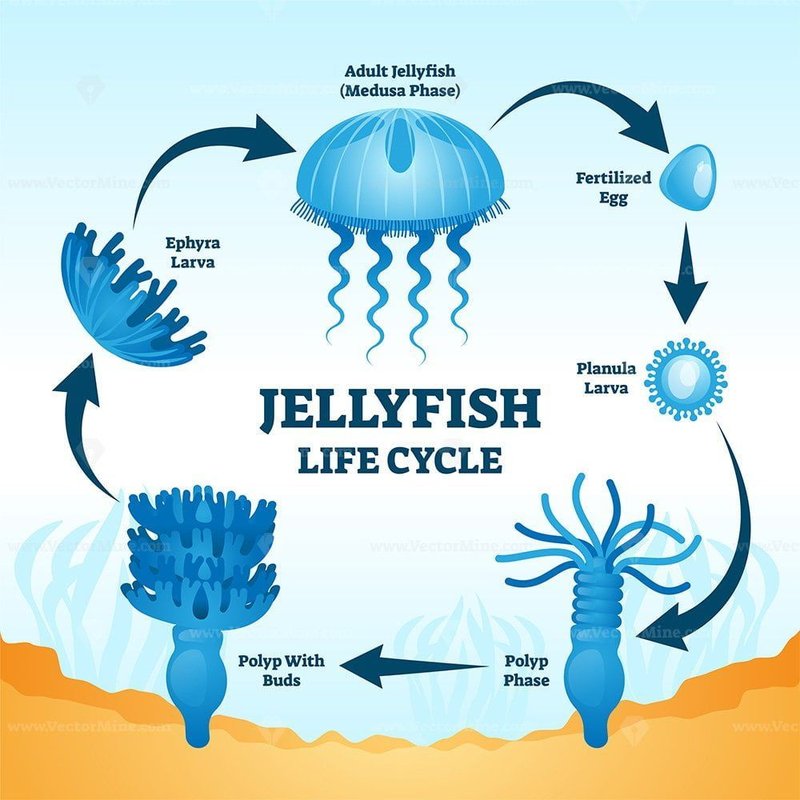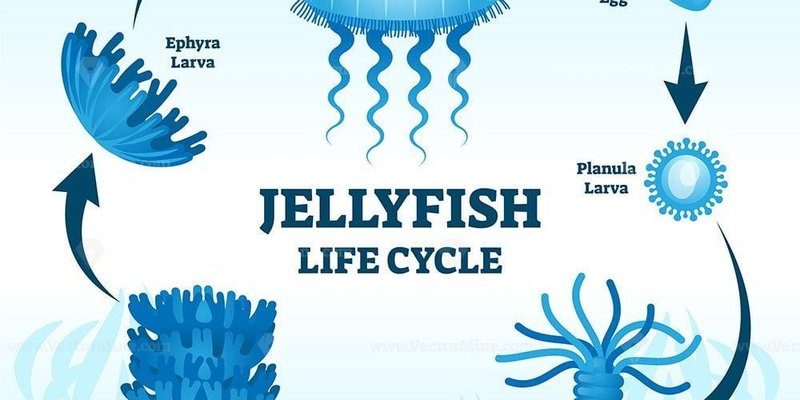
So, how do box jellyfish breed? Well, it’s not just your average spawning. These jellyfish have a rather adventurous life cycle that involves a transformation from polyp to medusa. Think of it like a caterpillar turning into a butterfly—only underwater and with a bit of a sting!
The Life Cycle of a Box Jellyfish
The journey of a box jellyfish starts in a way that may surprise you. They begin life as tiny polyps attached to a surface, often coral or rocks. Picture a small sea anemone, clinging stubbornly to its spot. These polyps can reproduce asexually by budding off new polyps, which is like having multiple mini versions of themselves sprouting up.
Once conditions are right—usually when the water temperature rises—they begin to transform into the more familiar jellyfish shape, called medusa. This is where the fun begins! The polyps release their buds into the water, and these young medusae are free-swimming and ready to explore the ocean.
As medusae grow, they start to develop the features that make box jellyfish so distinctive. Their bodies take on a bell shape, and they grow tentacles that can reach several feet long. These tentacles are crucial for their survival, allowing them to capture prey and defend themselves from predators.
Reproduction Methods: Sexual vs. Asexual
Box jellyfish can reproduce in two main ways: asexually as polyps and sexually as adult medusae. Let’s break that down a bit. Asexual reproduction is straightforward; the polyps simply clone themselves by budding. This means one polyp can create many new ones, ensuring the species can thrive when conditions are favorable.
On the flip side, when medusae are ready to mate, they engage in sexual reproduction. During this process, both male and female jellyfish release sperm and eggs into the water. It’s somewhat like a mating dance, but instead of a fancy ballroom, they’re performing in the open ocean. Here’s the thing: timing is crucial. They often synchronize their spawning with environmental cues, like lunar cycles or water temperature changes, to maximize the chances of fertilization.
Once the eggs are fertilized, they develop into tiny larvae, which eventually settle down and transform back into polyps, continuing the cycle. It’s a full circle of life that underscores the resilience of these fascinating creatures.
The Importance of Environmental Factors
You might be wondering how environmental factors affect reproduction in box jellyfish. Well, they play a significant role! Temperature, salinity, and food availability can influence their breeding cycles. For example, warmer waters often trigger spawning events. This is crucial because it aligns their reproductive efforts with times when food is abundant, ensuring that the young jellyfish have enough resources to survive.
Additionally, pollution and habitat destruction can disrupt these delicate cycles. When the environment changes, it can impact the availability of suitable surfaces for polyps to settle on or the conditions needed for larval development. This is why protecting marine ecosystems is so vital, not just for box jellyfish but for the entire oceanic food web.
Box Jellyfish Mating Behavior
So, what happens during mating season for box jellyfish? It’s quite the spectacle! Male and female jellyfish are known to congregate in areas where they feel safe, often in shallow waters. Here, they release their gametes into the water, creating a cloud of sperm and eggs.
Interestingly, female box jellyfish can hold onto sperm for several days, allowing them to choose the optimal moment to fertilize their eggs. This level of selectivity highlights the incredible adaptability of these creatures. And get this: their mating behavior can also change based on factors like the density of other jellyfish in the area.
Within a few days after fertilization, the fertilized eggs will develop into planula, small larvae that will eventually settle and transform into polyps. This phase is critical, as successful settlement determines the future of the jellyfish population.
Challenges in Breeding and Survival
While box jellyfish have remarkable breeding strategies, they face numerous challenges in their life cycle. Predation is a significant threat at all stages—whether it’s small fish snacking on polyps or larger marine animals going for the medusa. These jellyfish have to be quick and smart, using their stings as a defense mechanism.
Moreover, human activity plays a big role in their survival. Overfishing, climate change, and pollution can disrupt their habitats, making it harder for them to reproduce successfully. It’s a stark reminder of how interconnected our world is, where the fate of a jellyfish can hinge on actions taken far outside their ocean home.
Why Understanding Box Jellyfish Reproduction Matters
Understanding the breeding and reproduction of box jellyfish is crucial for many reasons. First, it gives us insight into the health of marine ecosystems. Since jellyfish populations can indicate changes in ocean health, monitoring them helps scientists track broader environmental shifts.
Secondly, as box jellyfish populations can bloom and become more abundant, especially in nutrient-rich waters, they can affect local fisheries and the balance of marine life. Knowing their reproductive habits allows us to predict and manage these blooms effectively.
Lastly, studying their unique reproductive strategies can inspire scientific research, perhaps even in biomedical fields, given their fascinating biological structures and compounds. Honestly, every little piece of knowledge about these creatures contributes to our understanding of marine biology and conservation efforts.
In conclusion, the breeding and reproduction of box jellyfish is an intricate dance between survival, adaptation, and the environment. Their life cycle—from polyp to medusa—highlights the complexities of marine life and the importance of maintaining healthy ocean ecosystems. Protecting these ecosystems not only safeguards the box jellyfish but also the myriad of life forms that rely on the ocean for their survival.

